Fall 2024 viewing round-up, part four

Despite having a large backlog of movies I haven’t yet seen, I continue to revisit familiar titles, usually because I’ve upgraded from older DVD editions. While there can be undeniable pleasure in re-watching movies, it’s nonetheless true that sometimes I go back to movies which are not necessarily the best. This isn’t about exploring the depths of great cinema to discover new meanings and nuances of the art. The impulse is not always explicable in rational terms. Sometimes it’s just a matter of chance, as when I happen across a discounted copy of a movie and pick it up on impulse.
Planet Terror (Robert Rodriguez, 2007)
That’s certainly the case with Robert Rodriguez’s Planet Terror and Quentin Tarantino’s Death Proof (both 2007), the Blu-rays of which were clearance priced at a local book store. These are the extended versions of the two movies Rodriguez and Tarantino made for Grindhouse, their homage to by-gone exploitation double-bills. I’ve always preferred Planet Terror, which embraces the project enthusiastically on its own terms; Death Proof, particularly in its longer version, can’t escape Tarantino’s worst tendencies – interminable, aimless pop-culture-infused chatter, a surfeit of references which are aggressively foregrounded to make sure the viewer knows how much Tarantino knows.
In Planet Terror, mercenaries steal a stockpile of a bio-weapon which is inadvertently released when they start fighting among themselves. The infection transforms people into, surprise, mindless zombies. A group of strangers wind up in a barbecue restaurant where they have to fight off a growing zombie army as well as the infection itself. Rodriguez fills the movie with familiar tropes, piles on the gore, and gets his cast to commit enthusiastically, managing to balance the elements just right so it plays both as genre parody and authentic B-movie horror.
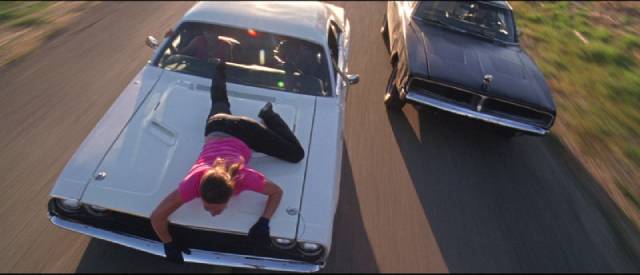
Death Proof (Quentin Tarantino, 2007)
Tarantino never finds the right balance, though Death Proof does manage in its key sequences to emulate car-centric action movies of the ’70s like Dirty Mary and Crazy Larry (John Hough, 1974) and, more particularly, Vanishing Point (Richard C. Sarafian, 1971). But the road action is surrounded by those interminable conversations – in this case, among a group of women stunt performers – Zoë Bell (using her own name and status as star stunt performer), Rosario Dawson and Sydney Poitier – who drive around and talk and talk and talk before encountering a psycho driver in the final act. The psycho is Stuntman Mike (Kurt Russell), who we’ve seen in the first act using his reinforced stunt car to kill a woman (Rose McGowan) who makes the mistake of accepting his offer of a ride.
When the trio of women see a white Dodge Charger for sale – the “Kowalski car” from Vanishing Point – they talk the owner into letting them take it for a test drive. Once out on a deserted road, Bell climbs on the hood and urges Dawson to hit the gas. Unfortunately, they’re spotted by Mike, who starts playing with them at high speed. As in those ’70s movies, the stunts look extremely dangerous – they’re done for real, without resorting to CGI – as the women have to turn things around and outwit Mike. Which they do, eventually running him off the road and beating the crap out of him as he, like a typical bully, whines and cries as he’s stripped of his macho posturing.
While Planet Terror benefits from the added running time, Death Proof is marginally better in its Grindhouse context because the chatter is reduced. While both movies feature copious extras on the Lionsgate disks, Planet Terror gets a supplementary disk to accommodate them all.
*
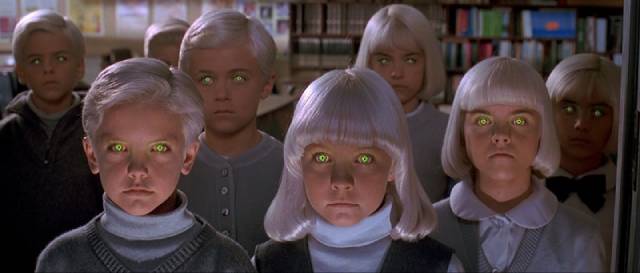
Village of the Damned (John Carpenter, 1995)
I don’t think I’d seen John Carpenter’s Village of the Damned (1995) since its original theatrical release almost thirty years ago. Apart from his two attempts at going mainstream – Starman (1984) and Memoirs of an Invisible Man (1992) – this misguided remake of Wolf Rilla’s classic 1960 adaptation of the John Wyndham novel is perhaps Carpenter’s least memorable movie. I decided to revisit it because it was among a bunch of movies a friend was getting rid of and I wondered whether it might seem different now as my opinion of a number of Carpenter’s movies has improved over the years. But alas it still seems rather dull and unnecessary. I was intrigued to learn from the disk extras, however, that the distributor had drastically cut the movie down – something which had left the director and members of the cast dissatisfied with the version released. Though it’s obviously impossible to say whether additional material might have improved the film, I’d be interested to see a director’s cut which, reportedly, included more character development and more detail about the impact of the situation on the community.
In general outline, the movie follows the narrative of Wyndham’s novel and Rilla’s movie – though rather than a quiet English village, the setting is a small coastal town in California. During an inexplicable event, the entire population is rendered unconscious for hours and not long after it’s discovered that all the women are pregnant. When the kids are born, they’re all little blond monsters who have the power to control others with their minds, their overreaction to perceived threats resulting in injury and death to parents and neighbours. With other communities around the world experiencing the same phenomenon, it appears that the kids may be the vanguard of an alien invasion and efforts to study them turn into attempts to destroy them – in this small town that task falls on the shoulders of the local doctor (Christopher Reeve) who has been trying to teach them.
But with underdeveloped characters and a lack of dramatic tension, the movie just seems to be going through the motions as if summarizing the original story without actually fleshing out the narrative to make it matter.
*
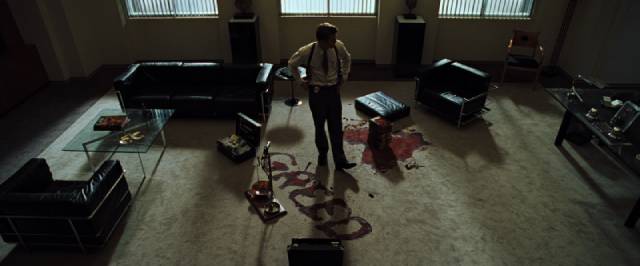
Se7en (David Fincher, 1995)
I hadn’t watched David Fincher’s breakthrough movie Se7en (1995) in years, but picked up a discount copy at the same time as Planet Terror and Death Proof. I’d really liked Alien 3 (1992), even though that had been a problematic production (much of the budget had already been spent before Fincher was given the job, so he’d had to make a lot of compromises – which just makes it all the more impressive), but in Se7en he was able to do exactly what he wanted. If Andrew Kevin Walker’s script is essentially a glorified B-movie whose central conceit doesn’t entirely hang together – John Doe’s project isn’t really narratively coherent and by the end appears to be improvised on the fly rather than a grand philosophical statement about human iniquity – Fincher transforms it into a dense, layered work of art. As a piece of world-building, it matches Blade Runner (1982) and Dark City (1998) as a masterpiece of neo-noir. I’m glad I had an excuse to watch it again.
*
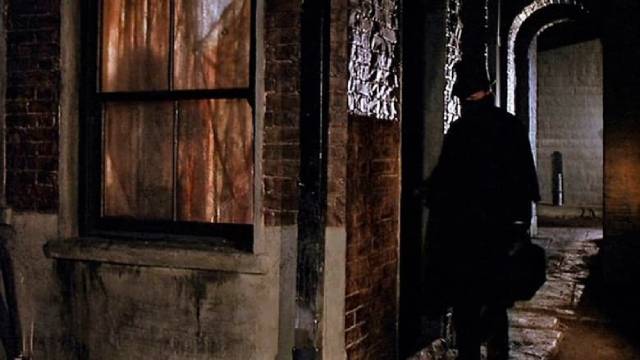
Jack the Ripper (David Wickes, 1988)
A more conventional serial killer haunts David Wickes’ Jack the Ripper (1988), a two-part production from Euston Films for Thames Television. With excellent production values and an impressive cast led by Michael Caine, featuring Susan George, Armand Assante and Harry Andrews among others, it’s conceived as a period police procedural with a flawed investigator – Caine’s disgraced Inspector Abberline is an alcoholic who is initially given the case because he knows Whitechapel well and his superiors don’t actually care much about the first victims, who, as prostitutes, have little value to society. It’s only as the killings continue and provoke increasing unrest among the population of London that a sense of urgency takes hold. Abberline pursues the case diligently, but his superiors don’t really care about finding the actual killer – they just want an arrest to placate the mob.
The production does a fairly good job of evoking the poor, working class milieu as well as the social and political attitudes of the upper classes who initially dismiss serious concern about the murders and only gradually become concerned as the killings pose a threat to their authority. Caine starts as a broken man, but his basic humanity awakens a sense of purpose which keeps him going even as the evidence begins to implicate those upper classes; this is anathema to the police authorities and he’s eventually removed from the investigation.
As for the script’s solution to the unsolved case, it follows a well-trodden path – echoing Bob Clark’s Murder By Decree (1979) in identifying the royal surgeon as the killer, although giving him a different motive. Here, he’s slipped into insanity and his murders are a bizarre form of “research” rather than a cover-up for an embarrassing royal romance. Jack the Ripper is a straightforward retelling of the familiar tale, without the romanticism of Clark’s movie or the flashy style of the Hughes Brothers’ From Hell (2001); it could easily have served as the model and inspiration for Ripper Street (2013-16).
The 2024 two-disk set from Old Gold Media appears to be an exact duplicate of the 2017 Network release, with the two-part, full-frame TV version on disk one and a cut-down, widescreen feature version on disk two, along with twenty-two minutes of scenes from an earlier, aborted attempt shot on videotape with Barry Foster as Abberline, which makes for an interesting comparison.
*
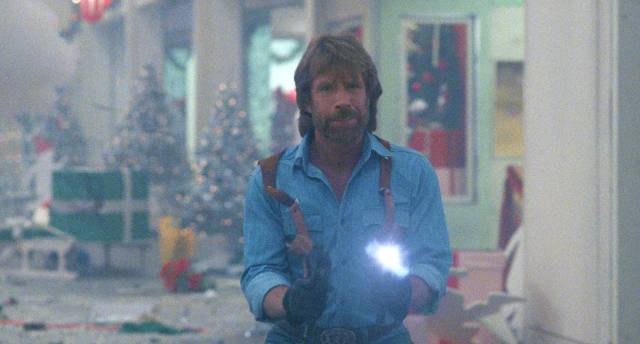
Invasion U.S.A. (Joseph Zito, 1985)
It’s a paradox that the country with more power than any other in history has deeply ingrained feelings of vulnerability, a perpetual nagging sense of victimhood. And yet, during the Reagan years, as the U.S. aggressively attacked numerous smaller states which it believed to be a threat to that power – in addition to perennial Cold War adversary the Soviet Union, Nicaragua and, absurdly, Grenada – Hollywood made jingoistic movies which asserted that America was the underdog. Perhaps the key text was John Milius’s Red Dawn (1984), which sees the country invaded by Cuban and Nicaraguan forces on behalf of the Soviet Union, these tiny countries somehow defeating the U.S. military on home turf until a small town high school football squad manages to drive them out. The sheer absurdity of Milius’s scenario is swept away by the excess of testosterone-fuelled chutzpah on display.
The next year, George Pan Cosmatos’s Rambo: First Blood Part II (1985) sent Sylvester Stallone’s vet back to Vietnam to finish the job weak-willed politicians and military leaders had left undone a decade earlier, single-handedly defeating the Vietnamese army as he rescues P.O.W.s from a hell-hole jungle camp. That narrative had been given a trial run the previous year in Joseph Zito’s Missing in Action (1984), which starred karate champion Chuck Norris, who had parlayed his martial arts skills into a successful movie career after fighting Bruce Lee in Rome in The Way of the Dragon (1972). Norris and Zito re-teamed in 1985 for Invasion U.S.A., which borrowed its core philosophy as well as its title from Alfred E. Green’s Red Scare movie Invasion, U.S.A. (1952), with the country, weakened by a lack of conviction, being invaded by the Soviets.
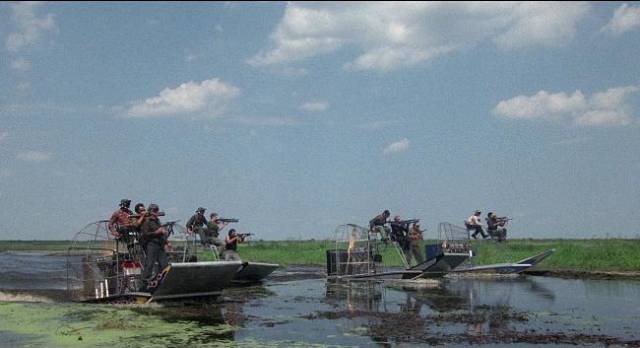
Norris as former CIA agent Matt Hunter is inadvertently responsible for the coming devastation when, in the prologue, he spares the life of Russian agent Rostov (the always dependable Richard Lynch). Trying to live a quiet life after retirement, Hunter is drawn back into the geopolitical fray when Hispanic terrorists (probably Cuban?) slip into Florida and start a campaign of sabotage and murder intended to provoke the U.S. into social collapse in order to pave the way for a Commie takeover. These invaders are led by Rostov, whose hatred of Hunter knocks the plan off track because he forgets the strategic purpose as he pursues personal revenge.
Everything about Invasion U.S.A. is absurd. Heavily armed enemy soldiers drive through suburbia and shoot up families happily celebrating Christmas; Hunter tells his former bosses that he has to work alone and drives around in his truck, somehow miraculously managing to find his way to each new atrocity just as it’s getting underway. This is Reagan’s America where the government is incapable of accomplishing anything and must get out of the way so that a determined individual can get the job done. The sloppiness of the writing and direction hit their peak when Rostov and his crack team of killers take airboats across the bayou to Hunter’s remote home, shoot the shit out of it from the water, fire an RPG into the house and, after the big explosion, just turn around and leave without taking a closer look – which is handy for Hunter, who had just jumped out of the back window and slipped into the swamp. With a villain this dumb, it’s not surprising that the lone hero manages to defeat the invasion all by himself.
Why Vinegar Syndrome gave the movie an extras-laden dual-format 4K upgrade is a mystery.
*
A couple of other genre films were far more satisfying.
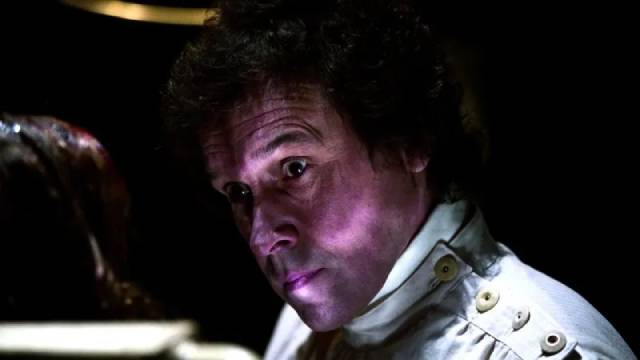
fear dot com (William Malone, 2002)
My favourite William Malone movie is his remake of House on Haunted Hill (1999), though his early features Scared to Death (1980) and Creature (1985) have their scrappy, low-budget charm. House was savaged by critics when it was released, but Malone’s follow-up fared even worse. Like most of his work, fear dot com (2002) is nothing if not full of references to other movies – in this case drawing on recent J-horror hits like Hideo Nakata’s Ring (1998) and Kiyoshi Kurosawa’s Pulse (2001). Perhaps it’s my affection for J-horror which makes me not mind fear dot com’s lack of a coherent narrative, which was certainly one of the main criticisms levelled at it.
A series of strange deaths leads detective Mike (Stephen Dorff) and public health official Terry (Natascha McElhone) to a website which promises terrible sights – that is, torture and murder at the hands of sinister doctor Alistair (Stephen Rea) who carves up his victims in a dank decommissioned industrial site. Anyone who logs in becomes infected with increasingly disturbing delusions until madness drives them to kill themselves. The avatar of whatever is haunting the site is a young girl in a white dress who bounces a white ball, thus bridging the decades-long divide between techno-horror and classic Italian Gothic cinema … because she’s none other than the murderous ghost of Mario Bava’s Kill, Baby… Kill! (1966) by way of the Devil in Federico Fellini’s Toby Dammit segment of Spirits of the Dead (1968).
With its mix of elements – techno-horror, Gothic ghost, slasher, neo-noir and a touch of torture porn – fear dot com is definitely a mess, but Malone and cinematographer Christian Sebaldt conjure up an effectively oppressive dank atmosphere, and brief appearances by Udo Kier, Jeffrey Combs, Nigel Terry and Michael Sarrazin liven things up. The Dark Star Blu-ray improves on the old Warner DVD, and comes with new and archival commentaries and featurettes.
*
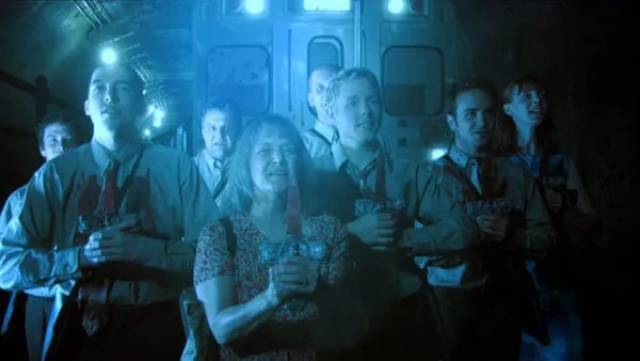
End of the Line (Maurice Devereaux, 2007)
Maurice Devereaux’s End of the Line (2007) is a modest but effective horror-thriller which takes place over a single, apocalyptic night. A nurse named Karen (Ilona Elkin) heads home on the subway after her shift. The train isn’t crowded but there are odd groups of well-dressed people wearing rather creepy smiles. At a certain point in the journey, they all receive pager signals, pull out ornate, cross-shaped daggers and begin stabbing other passengers to death. When the train stops in the tunnel, Karen and others flee onto the tracks and the night becomes a fight for survival against a fundamentalist cult which is determined to kill everyone who isn’t a member to prevent the unsaved becoming minions of Satan as the End Times begin. Like Michael Tolkin’s The Rapture (1991), End of the Line proposes that the Christian mythology is real and follows it to its logical conclusion – revealing the monstrous nature of its murderous deity as a full-blown horror. As dawn approaches and Karen emerges from the tunnels, it appears that the Rapture has arrived in an orgy of death; having carried out their assignments, killing the unsaved, the cult members are killing themselves in their eagerness to enter heaven.
In its broad outlines, the film follows the familiar trajectory of a zombie story, with a dwindling number of desperate characters trying to fight their way to a safety which no longer exists. Paranoia spreads as it becomes difficult to discern who might have been contaminated with the cult’s beliefs, and the question arises of whether fighting against them means aligning with the forces opposing God. But then would that be a bad thing since God is so obviously a monster…
The Terror Vision Blu-ray has an excellent image and is stacked with extras, including a commentary, a lengthy interview with Devereaux, a making-of featurette, festival screening footage and a deleted scene and trailer.
Comments